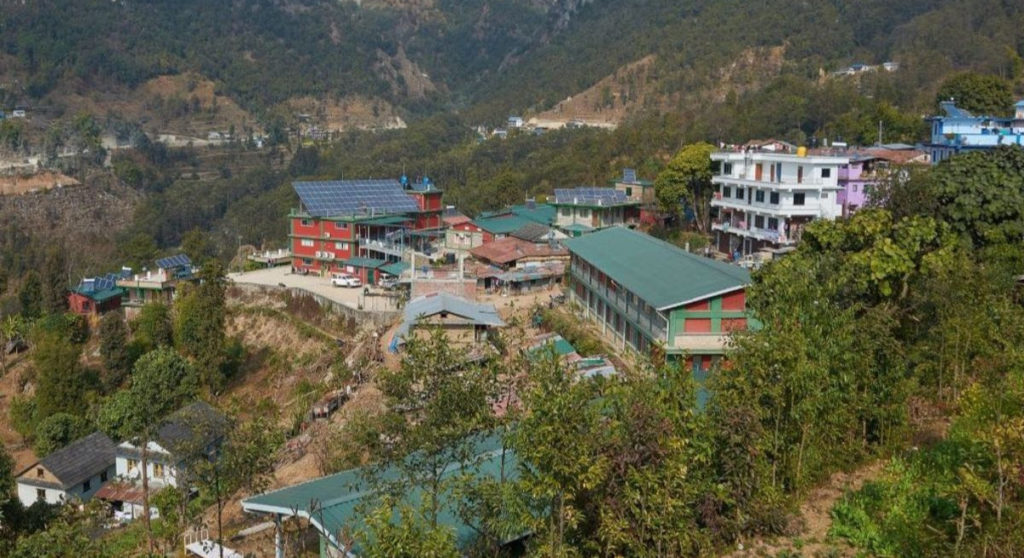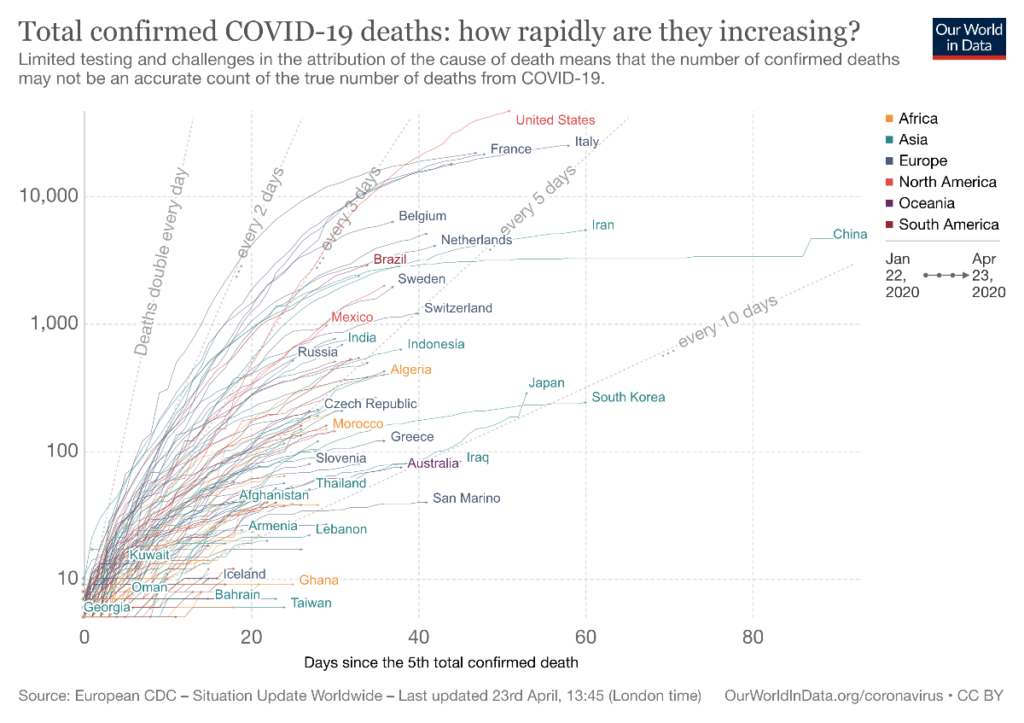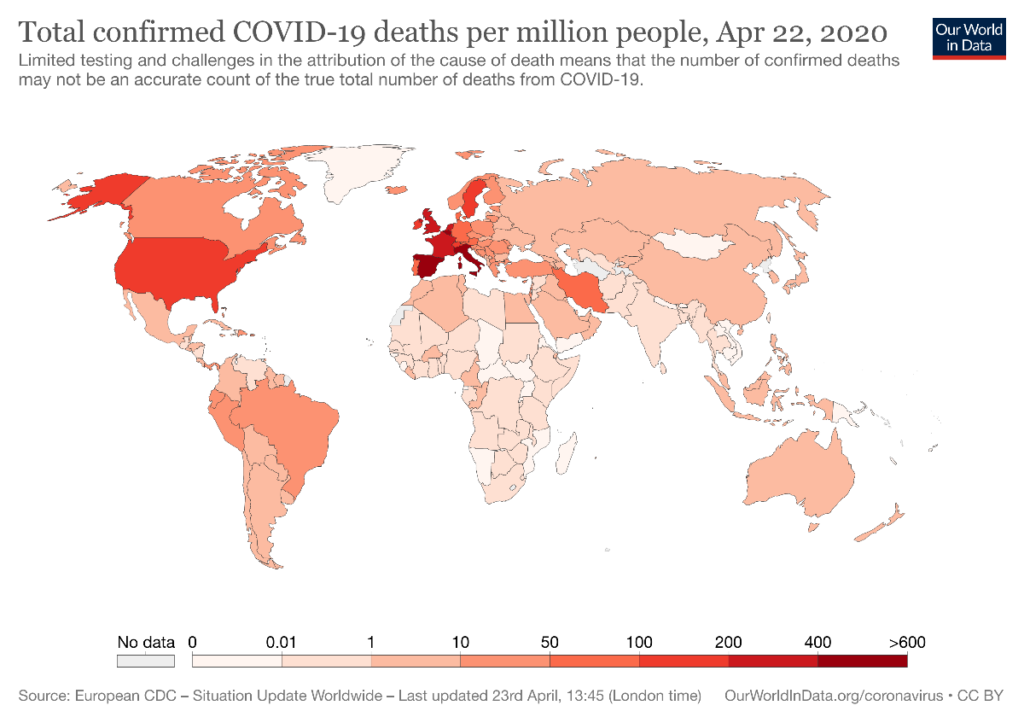Published: 04/24/2020
Dear Global Health Colleagues,
Our understanding of how SARS-CoV-2 spreads and causes disease continues to increase. In the last two weeks, however, we have also seen action to withhold funding for the World Health Organization and growing protests against public health measures. As a global community, it is critical that we work together against the pandemic and commit to helping vulnerable and underserved populations.
Recently published studies have illustrated striking associations between public health interventions and reduced disease transmission in Wuhan and Hong Kong. New modeling forecasts the growing burden of COVID-19 in crowded areas, among homeless individuals, and on women seeking sexual and reproductive health care. Reports and editorials call on countries to better help migrant workers, indigenous peoples, and racial minorities. A disturbing, non-peer reviewed report from South Korea also raises issues about reinfection or viral reactivation after negative PCR testing. We share some of this work below, which we hope you will find helpful.
Stay healthy.
In solidarity against COVID-19,
Michele Barry
Drs. Ben and A. Jess Shenson Professor of Medicine and Tropical Diseases
Director of the Center for Innovation in Global Health
Senior Associate Dean for Global Health, Stanford University
Continue to monitor the following reliable websites for the global situation:
NIH/NLM | LitCovid—–LitCovid is a curated literature hub for tracking up-to-date scientific information about the 2019 novel Coronavirus. It is the most comprehensive resource on the subject, providing a central access to relevant articles in PubMed. The articles are updated daily and are further categorized by different research topics and geographic locations for improved access.
Resources
Global Trends and Topics
Female World Leaders Hailed as Voices of Reason Amid the Coronavirus Chaos (4/20/2020): This Washington Post article describes how elected female leaders around the globe have led successful efforts to control the spread of coronavirus. It profiles the approaches taken by New Zealand, Norway, Iceland, Germany, and Taiwan.
COVID-19 Update: Latest Developments in the Fight Against Coronavirus (4/13/20): Council for Foreign Affairs members Michele Barry, Jeffrey Milhorn, and Seth Berkley discuss COVID-19, including the global effects, U.S. response, vaccine efforts, and lessons learned thus far.
Respiratory Support in Novel Coronavirus Disease (COVID-19) Patients, with a Focus on Resource-Limited Settings (4/21/20): In the American Journal of Tropical Medicine and Hygiene, Arjen Dondorp et al. review current guidance for COVID-19 ventilatory support in resource-limited settings. They acknowledge limitations of supplies including oxygen, blood gas analyzers, imaging equipment, and ventilators, and they describe strategies for optimizing non-invasive and invasive ventilation.
Estimates of the Potential Impact of the COVID-19 Pandemic on Sexual and Reproductive Health in Low- and Middle-Income Countries (4/16/20): Taylor Riley et al. from the Guttmacher Institute use data from the 2019 Adding It Up study to present two scenarios of how COVID-19 could disrupt sexual and reproductive healthcare in LMICs. They estimate that a 10% decline in use of sexual and reproductive healthcare services could lead to 15.4 million additional unintended pregnancies and 1.7 million additional women experiencing major obstetric complications without care.
Crowding and the Epidemic Intensity of COVID-19 Transmission (4/20/20): In this preliminary paper, Benjamin Rader et al. analyze highly-resolved spatial variables for cities in China and show that the intensity of COVID-19 is strongly shaped by crowding. They use their model trained on cities in China to forecast epidemic intensity around the world and predict that cities in sub-Saharan Africa will face especially high COVID-19 burdens.
Covid’s Medical Devastation Will be Felt by Millions Who Never Contract the Disease (4/21/20): Andrew Chang and Michele Barry describe how the pandemic harms patients with chronic diseases through diversion of resources and decreased treatment.
Country-Specific News
Association of Public Health Interventions With the Epidemiology of the COVID-19 Outbreak in Wuhan, China (4/10/20): In a study published in JAMA, Pan et al. examine the outcomes of nonpharmaceutical interventions (NPIs) across five time periods during the COVID-19 outbreak in Wuhan, China. For each time period, they provide estimations of the average numbers of cases caused by each infected individual (Rt). The authors show a striking association between NPIs and reduced disease transmission.
Impact Assessment of Non-Pharmaceutical Interventions against Coronavirus Disease 2019 and Influenza in Hong Kong: an Observational Study (4/17/20): Similar to the above study of Wuhan, this article by Benjamin Cowling et al. in The Lancet shows that NPIs are associated with reduced transmission of COVID-19 in Hong Kong.
Africa in the Path of Covid-19 (4/17/20): The WHO has warned that Africa could become the next epicenter of the pandemic. In the NEJM, Wafaa El-Sadr and Jessica Justman describe the growing challenges most African countries face confronting COVID-19 and call for urgent, coordinated global action.
Singapore Lost Control of Its Coronavirus Outbreak, and Migrant Workers are the Victims (4/21/20): The Washington Post explores both why Singapore’s second wave of coronavirus infections has grown rapidly and why nearly 70% of the country’s total cases are concentrated in dormitories that house migrant workers.
Protect Indigenous Peoples from COVID-19 (4/17/20): In a letter to Science, Lucas Ferrante and Philip Fearnside describe the threat COVID-19 poses to Brazil’s indigenous peoples and call on Brazil’s government to take urgent action.
Recovered Coronavirus Patients are Testing Positive Again. Can You Get Reinfected? (4/18/20): CNN describes an intriguing report of 163 patients who recovered from COVID-19 with negative tests and then tested positive with mild symptoms recrudescing. Non-infectious viral RNA detection, false positives, false negative tests, reinfection or reactivation were all hypothesized. Stay tuned for the peer reviewed study.
Domestic Underserved Populations and Health Disparities
Estimated Emergency and Observational/Quarantine Capacity Need for the U.S. Homeless Population Related to COVID-19 Exposure by County; Projected Hospitalizations, Intensive Care Units, and Mortality (4/3/20): In a preliminary paper, Dennis Culhane et al. estimate the morbidity and mortality of COVID-19 among the homeless population in the United States and project that homeless individuals infected by COVID-19 will be twice as likely as those in the general population to be hospitalized, two to four times as likely to require critical care, and two to three times as likely to die.
COVID-19 and African Americans (4/15/20): Clyde Yancy, in JAMA, writes that “A 6-fold increase in the rate of death for African Americans due to a now ubiquitous virus should be deemed unconscionable.” He explains how comorbidities, social determinants of health, and challenges with social distancing contribute to disproportionate suffering and calls for society to address existing health care disparities.
Partners In Health to Help State Trace Contacts of COVID-19 Patients in Landmark Agreement with MA Gov’s Office (4/20/20): The Massachusetts Department of Public Health is collaborating with the global health organization Partners in Health to hire and train 1,000 contact tracers.
Notes from the field: Bangladesh

Notes from Deirdre and Mark Zimmerman at Stanford’s partnered Patan Hospital in Nepal. Mark is a professor and senior consultant in internal medicine at Patan Hospital, Deirdre is a consulting dietitian.
Nepal identified its first case of COVID-19 in early January, in a Nepali student returning from China. The young man spent a few days with mild illness at the tropical medicine hospital and made a full recovery. And then… nothing. No cases amongst the 150 Nepali students on an evacuation flight from Wuhan, no cases from the thousands of Chinese and Korean visitors to Nepal, no significant increase in the number of cases of severe pneumonia appearing in hospitals.
As new ‘hot spots’ and spiraling statistics emerged from around the world, a mixed sense of both anxiety and disbelief began to swell as the Nepali population watched and waited for the disease to strike. Still, the tension led to a brief run on cooking gas and a scarcity of face masks, only mildly relieved when security forces found 2 million masks being hoarded by black marketeers.
In the last few weeks, life here has changed dramatically. The schools closed first, and then suddenly, without any notice or chance to prepare, the government announced a nation-wide full lock-down. The streets became silent and empty in a way we had not seen before, even for curfews during the civil war and general strikes during political unrest.
Nepal is incredibly vulnerable to a disaster like Coronavirus; most district hospitals have inadequate handwashing facilities, let alone critical care facilities. We feel like we are bracing for the arrival of a hurricane, even as preparations are completed at Patan Hospital for a COVID-19 unit with 18 beds with ventilators, completely separated from the main wards which are now emptied of all but the most serious cases. Non-essential surgeries have been cancelled, outpatient clinics are almost empty, and medical staff are working on light rotations in this seeming ‘calm before the storm’. Meanwhile, spring has arrived, the smog and dust across the city have completely dissipated with the lack of traffic, and we are enjoying glorious views of the Himalayas.


Upcoming Events and Lectures
Virtual Town Hall on COVID-19 Response in Low- and Middle-Income Countries
Tuesday, April 28 from 9:00 am PT
The Kaiser Family Foundation and Global Health Council will present a discussion on the challenges and opportunities of resource mobilization in response to COVID-19 in LMICs. This is the third discussion in the GHC conversation series on COVID-19.
Association of American Colleges and Universities (AAC&U) Faculty Friday Webinar: Shaping Teaching & Learning to Address a Global Health Crisis – COVID-19 and Global Health | Friday, May 1, 2020 at 11:00 am PT
The AAC&U is hosting a conversation with global health professionals about COVID-19-related changes in global health education and implications of the pandemic for higher education.
New Funding Opportunities Specific to COVID-19
Weiss Fund COVID-19 RFP
The Weiss Fund at Harvard is requesting applications for research that contributes to understanding and addressing the effects of the current COVID-19 pandemic on disadvantaged populations in the developing world. This is an open call to members at eligible institutions, including Stanford.
Deadline: April 26, 2020.
Online List of COVID-19 Research Opportunities
Stanford’s Research Management Group has created a website that provides a complete listing of funding opportunities for COVID-19 research. The site also provides sponsor and University guidance on grants, clinical trials, and award management impacted by COVID-19.
COVID-19 Research at Stanford
Stanford Medicine scientists have launched dozens of research projects as part of the global response to COVID-19. Some aim to prevent, diagnose and treat the disease; others aim to understand how it spreads and how people’s immune systems respond to it.

